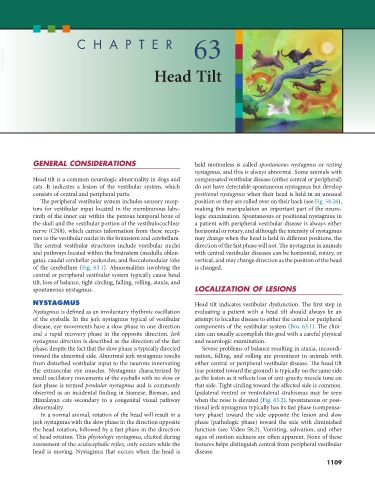Page 1137 - Small Animal Internal Medicine, 6th Edition
P. 1137
CHAPTER 63
VetBooks.ir
Head Tilt
GENERAL CONSIDERATIONS held motionless is called spontaneous nystagmus or resting
nystagmus, and this is always abnormal. Some animals with
Head tilt is a common neurologic abnormality in dogs and compensated vestibular disease (either central or peripheral)
cats. It indicates a lesion of the vestibular system, which do not have detectable spontaneous nystagmus but develop
consists of central and peripheral parts. positional nystagmus when their head is held in an unusual
The peripheral vestibular system includes sensory recep- position or they are rolled over on their back (see Fig. 58.26),
tors for vestibular input located in the membranous laby- making this manipulation an important part of the neuro-
rinth of the inner ear within the petrous temporal bone of logic examination. Spontaneous or positional nystagmus in
the skull and the vestibular portion of the vestibulocochlear a patient with peripheral vestibular disease is always either
nerve (CN8), which carries information from these recep- horizontal or rotary, and although the intensity of nystagmus
tors to the vestibular nuclei in the brainstem and cerebellum. may change when the head is held in different positions, the
The central vestibular structures include vestibular nuclei direction of the fast phase will not. The nystagmus in animals
and pathways located within the brainstem (medulla oblon- with central vestibular diseases can be horizontal, rotary, or
gata), caudal cerebellar peduncles, and flocculonodular lobe vertical, and may change direction as the position of the head
of the cerebellum (Fig. 63.1). Abnormalities involving the is changed.
central or peripheral vestibular system typically cause head
tilt, loss of balance, tight circling, falling, rolling, ataxia, and
spontaneous nystagmus. LOCALIZATION OF LESIONS
NYSTAGMUS Head tilt indicates vestibular dysfunction. The first step in
Nystagmus is defined as an involuntary rhythmic oscillation evaluating a patient with a head tilt should always be an
of the eyeballs. In the jerk nystagmus typical of vestibular attempt to localize disease to either the central or peripheral
disease, eye movements have a slow phase in one direction components of the vestibular system (Box 63.1). The clini-
and a rapid recovery phase in the opposite direction. Jerk cian can usually accomplish this goal with a careful physical
nystagmus direction is described as the direction of the fast and neurologic examination.
phase, despite the fact that the slow phase is typically directed Severe problems of balance resulting in ataxia, incoordi-
toward the abnormal side. Abnormal jerk nystagmus results nation, falling, and rolling are prominent in animals with
from disturbed vestibular input to the neurons innervating either central or peripheral vestibular disease. The head tilt
the extraocular eye muscles. Nystagmus characterized by (ear pointed toward the ground) is typically on the same side
small oscillatory movements of the eyeballs with no slow or as the lesion as it reflects loss of anti-gravity muscle tone on
fast phase is termed pendular nystagmus and is commonly that side. Tight circling toward the affected side is common.
observed as an incidental finding in Siamese, Birman, and Ipsilateral ventral or ventrolateral strabismus may be seen
Himalayan cats secondary to a congenital visual pathway when the nose is elevated (Fig. 63.2). Spontaneous or posi-
abnormality. tional jerk nystagmus typically has its fast phase (compensa-
In a normal animal, rotation of the head will result in a tory phase) toward the side opposite the lesion and slow
jerk nystagmus with the slow phase in the direction opposite phase (pathologic phase) toward the side with diminished
the head rotation, followed by a fast phase in the direction function (see Video 58.2). Vomiting, salivation, and other
of head rotation. This physiologic nystagmus, elicited during signs of motion sickness are often apparent. None of these
assessment of the oculocephalic reflex, only occurs while the features helps distinguish central from peripheral vestibular
head is moving. Nystagmus that occurs when the head is disease.
1109

